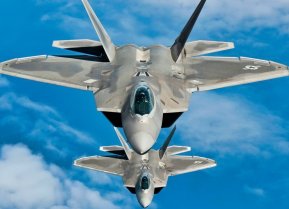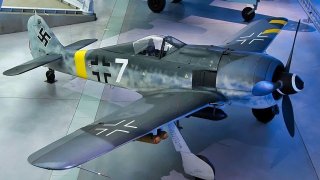Focke-Wulf Fw 190: Nazi Germany's Best World War II Combat Plane?
Along with the well-known Messerschmitt Bf 109, the Focke-Wulf Fw 190 became the backbone of the Luftwaffe's Jagdwaffe (fighter force) during the Second World War.
Meet the Focke-Wulf Fw 190: Along with the well-known Messerschmitt Bf 109, the Focke-Wulf Fw 190 became the backbone of the Luftwaffe's Jagdwaffe (fighter force) during the Second World War.
The German single-seat, single-engine fighter first appeared in the skies over Europe in August 1941 and was arguably the most advanced combat aircraft in front-line service in the world.
More than 20,000 were produced before the war ended, and some of the Luftwaffe's most successful fighter aces claimed many of their kills while flying. The Fw 190 offered greater firepower than the Bf 109, and it was far more maneuverable at low to medium altitudes.
Notable Fw 190 Facts
The aircraft became known as the "Butcher Bird" – and on October 14, 1943, a squadron of Fw 190s decimated U.S. bombers attacking Schweinfurt and Regensburg, shooting down 79 of the 376 Allied aircraft.
The Fw 190 also proved to be a dangerous opponent in a dogfight, as it was equipped with heavy armament, offered excellent maneuverability and high speed. The Fw 190's cockpit was a major improvement over the Bf 109s, as it offered all-electric-power systems, provided excellent visibility and reasonable armor plating. The light controls of the aircraft also made it easy to fly.
The small size of the Fw 190 also offered an advantage in a dogfight, and the cut-down fuselage made it easy for pilots to see behind them.
The aircraft was steadily upgraded throughout the war, and the F and G variants – designed for ground attack – were fitted with armor plating and laminated glass to further help protect the cockpit.
While a more than capable aircraft with an experienced pilot at the controls, the Fw 190 often proved a challenge for inexperienced pilots – a fact noted as the war went as it could be a difficult plane to land.
True Warbird
The Fw 190s proved to be versatile aircraft and could carry a huge range of weapons, from bombs and rockets to aerial torpedoes. Later models were even fitted with a 30mm (1.18-inch) cannon and air-to-air rockets. The aforementioned Fw 190F and G models were also developed as a replacement for the antiquated Ju 87 "Stuka" dive bomber. Those models proved to be among the most capable attack aircraft used in the war.
The Fw 190s inflicted cruel punishment on Allied bombers, notably the American B-17 Flying Fortresses and B-24 Liberators. The bombers suffered heavy losses until the long-range P-51 Mustang was introduced in 1944 and was finally able to provide a fighter escort to counter the Butcher Bird.
Fw 190: A Tank Buster
The aircraft was designed by Focke-Wulf's lead aeronautical engineer and test pilot Kurt Tank – and it is almost fitting that a variant of the Fw 190 would be fitted with twin 30mm (1.8-inch) Mk 103 cannons (one on each wing) that were capable of destroying enemy tanks. The cannons were also devastating when employed against Allied bombers.
Another late-war variant, the Fw 190A-8/R8 was a heavily armored version that was designed to destroy American bombers by ramming them! The tactic was devised by Luftwaffe ace pilot Hans-Günter von Kornatzki, who proposed that fighters should ram the bombers after running out of ammunition.
Foreign Service
During the Second World War, a number of Fw 190s were supplied to Germany's allies including Hungary and Romania, while the Japanese Army Air Force had even been provided an Fw 190A-5 for evaluation purposes.
Spain, which was a de facto ally, was also provided a number of the aircraft – and many of those remained in service after the war. Around seventy fighters were exported to Turkey, and also were used post-war until they were retired due to lack of spare parts.
Finally, a number of surplus Fw 190s were employed post-war by the Polish and Yugoslavian Air Forces, while the French Armée de l'Air (French Air Force) also operated the Fw 190 – including sixty-five aircraft that were constructed at a former Luftwaffe factory in Cravant in the Yonne department in Bourgogne-Franche-Comté, north-central France. The newly built aircraft were designated the NC-900.
Today some 28 original wartime Fw 190s are in museums or in private collections. One is in the collection of the National Air & Space Museum in Washington, D.C., while another is on display at the National Museum of the United States Air Force at Wright-Patterson Air Force Base (AFB), Dayton, Ohio.
About the Author: Peter Suciu
Peter Suciu is a Michigan-based writer who has contributed to more than four dozen magazines, newspapers and websites. He regularly writes about military hardware, and is the author of several books on military headgear including A Gallery of Military Headdress, which is available on Amazon.com. Peter is also a Contributing Writer for Forbes.


